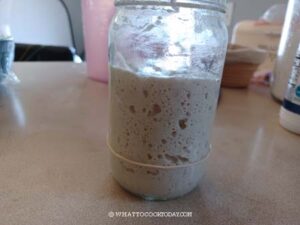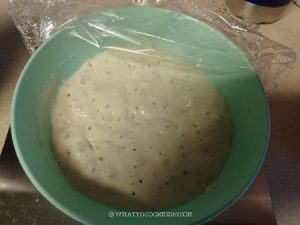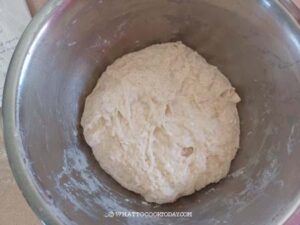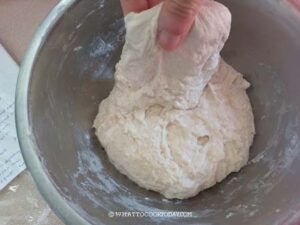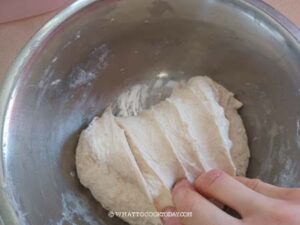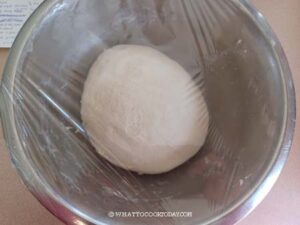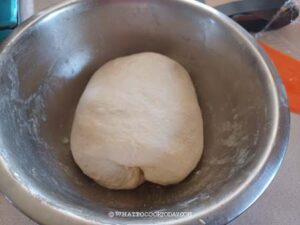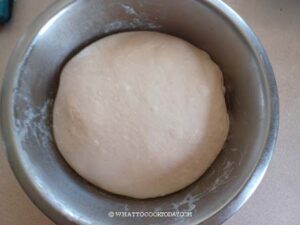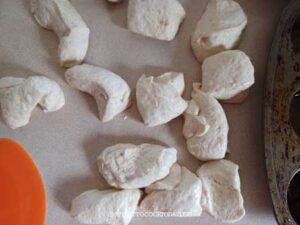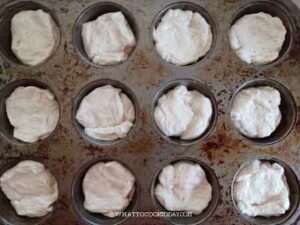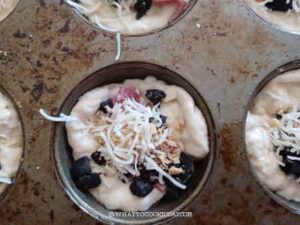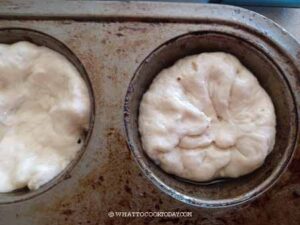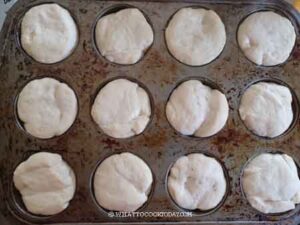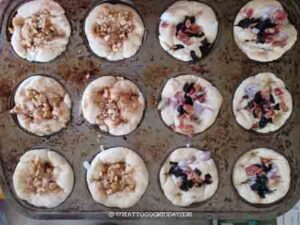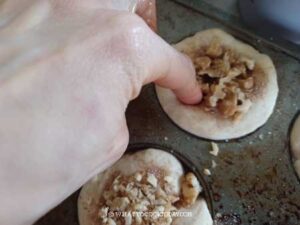This post may contain affiliate links. Please read our disclosure policy.
No-knead focaccia dough baked in a muffin tin to give you a crisp on the outside crust and soft and airy crumbs on the inside. They can be made savory or sweet. The recipe includes both the sourdough and yeast versions.

Okay, so ever since I discovered that I can bake focaccia in a muffin pan, my kids have requested this every week for breakfast and after-school snacks. They are the perfect size for breakfast and snacks.
Why you’ll love this recipe
1. The dough is so easy to make
Yes, it’s a no-knead focaccia!
2. They can be made sweet or savory
You can add sweet or savory toppings. My kids like both
3. You’ll like the texture
The crust is thin and crisp and the crumbs are airy and soft
4. Just the perfect size
My kids love them because of the size. They say “just the right size mom!”

No-Knead Focaccia Muffin
Ingredients
SOURDOUGH VERSION:
- 250 g bread flour (12.7% protein content)
- 100 g active starter (100% hydration)
- 6 g salt
- 7 g honey
- 190 g water
- 13 g extra virgin olive oil plus more for drizzling
YEAST VERSION:
Prepare poolish:
- 50 g bread flour
- 50 g water
- 1/16 tsp instant yeast just a small pinch
Main dough:
- 250 g bread flour (12.7% protein content)
- 190 g water
- 7 g honey
- 6 g salt
- ¼ tsp instant yeast
- 13 g extra virgin olive oil plus more for drizzling
Few ideas for savory topping: (the amounts are just estimates)
- 10 pitted olives finely chopped
- 4 Tbsp bacon bits
- 1 small onion finely chopped
- flaky sea salt
Few ideas for sweet topping: (the amounts are just estimates)
- 40 g finely chopped nuts
- 3 Tbsp sugar
- 1 tsp ground cinnamon
Instructions
Prepare the levain (for sourdough):
- To prepare levain: Since I know I will be baking the next day, I will prepare more starter the night before. I will feed at 1:5:5 ratio so it will last me until the next morning, about 8-10 hours to double or triple at 75-77 F (24-25C). This also depends on the strength of your starter and the room temperature the starter is at. It may be faster or longer. Combine 10 grams starter + 50 grams flour + 50 grams water in a jar. Stir until all is combined and no dry bits of flour.

To prepare poolish (for yeast version):
- Combine water, flour, and yeast. Stir until all is combined and no dry bits of flour. Cover loosely with a cling wrap and let it sit at room temperature. It takes about 10 hours for it to double in volume

Prepare the dough:
- The next day, combine all the ingredients in a large mixing bowl, including the starter or poolish. Stir with a spatula until you get a shaggy and sticky dough. Cover and let it rest for 30 minutes

Stretch and fold the dough:
- After the 30-minute rest, Scrape the sides of the bowl with a bench scraper or spatula to "clean" it up. Lightly wet your fingers and scoop the dough from the bottom and gently wiggle and stretch it up and fold it over.


- Do this about 4-5 times around the edge. This actions helps to develop gluten without having to knead the dough. The dough is sticky, so lightly wet your fingers help to prevent the dough from sticking to your fingers
- Round the dough up into a dough ball. Notice how much smoother and stronger the dough is now. Cover again and let it rest for 40 minutes

2 sets of coil and folds:
- After 40 minutes, lightly wet your fingers again and tuck your fingers underneath the dough on the side. Lift the dough up gently and it may stick to the bowl and that's fine, gently pull to release the dough from sticking to the bowl and let it coil and fold over itself. Rotate the container 90 degrees and do the same on the opposite side. After that rotate 45 degrees and do another coil fold and then rotate the container to coil fold the opposite side. So a total of 4 coil folds (one on each side). Let the dough rest for 40 minutes
- Repeat the second set of coil fold. You will notice that the dough is not as extensible anymore and much stronger

Continue to let it ferment:
- Cover the dough and let it continue fermenting until it is double or close to double in volume. The temperature of the place I put the dough in was about 82 F (28 C). It takes about 1-2 hours, depending on the temperature

Cold retard in the fridge:
- Once it has doubled in volume, drizzle some oil on the surface and gently rub it on top to prevent the dough from drying out. Cover tightly and put it in the codest part of your fridge to retard the fermentation
Shaping:
- Remove the dough from the fridge. Tip the container upside down to gently release the dough from the container. Without deflating the dough, divide it into 12 roughly equal pieces

- Drizzle oil into the well of your muffin pan. Make sure each well is well-coated with oil on the bottom, the inner wall, and the top edge (in case the muffin top grows big)
- Place one piece of dough into each well and use your finger to gently stretch it to fill up the bottom and cover the side of the pan.

- I want the savory focaccia muffin to have some filling inside so I scatter with half of the toppings

- Then fold the dough over to cover the topping. Then gently stretch the dough again to cover the bottom and the side of the pan. If it retracts back, give it a rest for 5 minutes and stretch again

- For sweet focaccia, I only use cinnamon sugar and nuts. So I will scatter them on top after final proofing
Final proofing:
- Let the dough proof again until really puffy, this may take about 1 1/2 -2 hours or a bit longer at 82 F (28 C)

Baking:
- 15 minutes before the end of proofing, preheat the oven to 450 F (230 C). Drizzle more oil on top of the dough. Scatter the rest of the savory toppings on top and flaky sea salt. For the sweet focaccia, sprinkle the cinnamon sugar and nuts (add some crunchy texture) on top.

- Oil your index finger and dimple each dough, about 3-4 dimple per muffin, all the way to the bottom

- Bake in the middle rack for 15 minutes or until golden brown and the internal temperature is 190 F (88C).

Remove from the pan immediately:
- Set the muffin pan on a cooling rack. Use an offset spatula to help you release the muffin from the pan and set the muffin on a cooling rack. Don't let the muffins sit in the pan because they will loose that crispness as the condensation from the hot steam collects at the bottom of the pan

To serve:
- They are the best when they are still warm. The crust is thin and crisp and the inside is spongy and slightly chewy
*Nutrition facts are just estimates and calculated using online tools*

How to store baked focaccia muffin
1. Let them cool down completely on a cooling rack
2. Store them in an air-tight container or wrap them individually in a plastic wrap and put in a sealed plastic bag
3. They can be kept at room temperature for a day or two
4. For a longer storage, keep the well-wrapped focaccia muffin in a freezer-bag, push all the air out and seal the bag. They can be kept frozen for a month
How to reheat leftover focaccia muffin
1. Air-fryer: If they are not frozen, sprinkle or mist with a bit of water and then reheat in a preheated air-fryer at 320 F for about 4-5 minutes. The crust will crisp up after it cools down a bit. If they are frozen, I recommend thawing them overnight in the fridge or at the counter for a few hours and then reheat
2. In the oven: If they are not frozen, sprinkle or mist with a bit of water and then reheat in a preheated oven at 350 F for about 5 minutes. The crust will crisp up after it cool down a bit. If they are frozen, I recommend thawing them overnight in the fridge or at the counter for a few hours and then reheat

